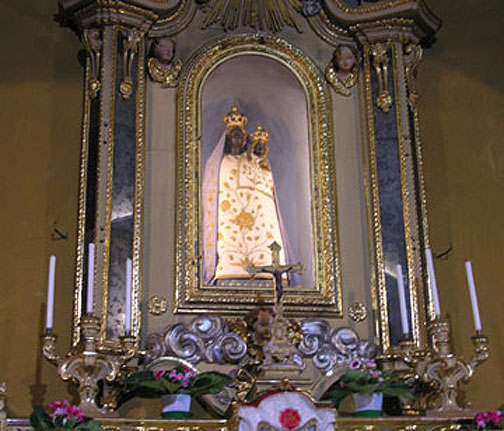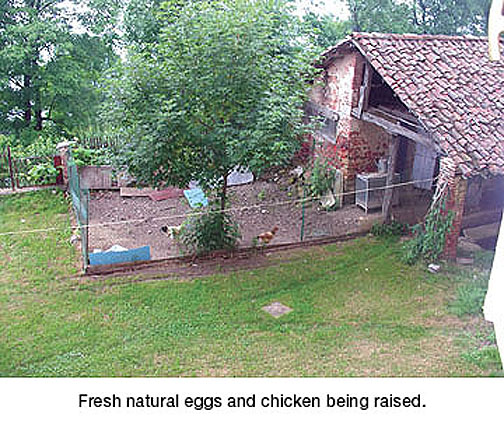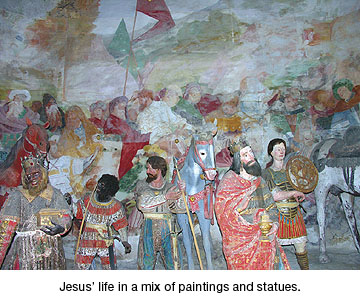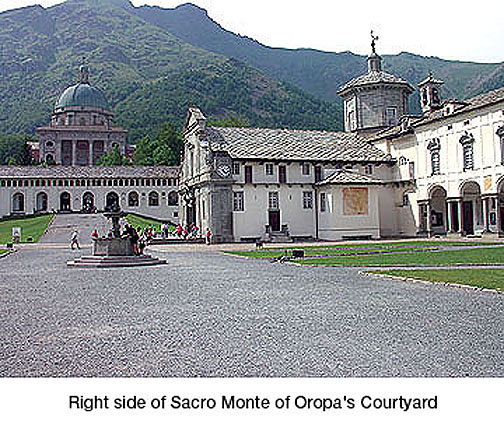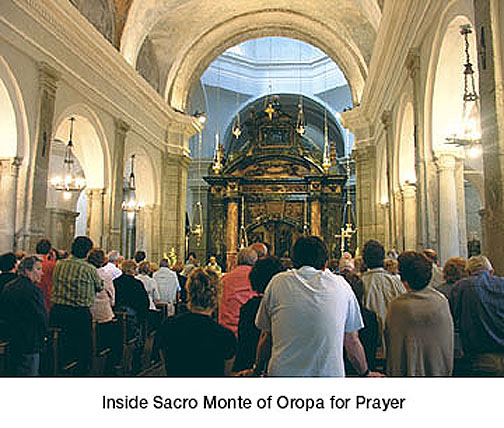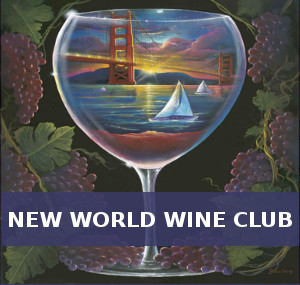Mike and Ellen Walsh continue their account of a very memorable trip to the Piedmont region of Italy. (If you missed part 1 of this, you can read it here.) We pick-up on the third morning of their travels.
Day 3
Graglia, a small village made up of the chief town and various hamlets of the area, includes the Sacro Monte of Graglia overlooking the Elvo Valley, located in the western Prealps of The Biella area. When the Sacro Monte itself was envisioned back in the early 1600s, it was slated to contain 100 chapels. But it was scaled down later and today only five remain. Duke Carlo Emmanuel 11 was the original backer of the project, and it was more than a century later that the church assumed its current appearance with a Greek cross plan surrounded by a 38 meter high dome.
One sanctuary in the complex, the Sanctuary of Our Lay of Loreto, contains the Pilgrim’s Hospice. The rooms are all completely refurbished, and offer a very economical approach to travel within the region. Accommodations for over 100 people are available, complete with cooking facilities, common rooms, and a very interesting 1500 book library of the religious history of the region.
The Sacro Monte has the recreational facilities of a full-scale resort. Lighted fields are available for volleyball, soccer, and bowls (a popular game from the U.K.). There is even a nine hole miniature golf course and in the winter, downhill skiing.
A short walk down the road from the Sacro Monte will transport you into lush mountain pastures ripe for exploring. Many trails are available for walking, mountain biking, or horseback riding. Rumor has it that one spot on the trail towards the Church of San Carlo has an echo that will bounce back up to eleven syllables. The only other place in the world with such an echo is the Grand Canyon.
Although you overlook the beautiful and serene Elvo Valley, you are but a bus ride, or one mile walk into the nearest village, where you can still discover ironwork shops, carpentry shops, and other small stores that feature the artisanal produce and dairy of the area, thanks to the Eco Museum of the Elvo and Serra Valley.
We dined in a small restaurant adjacent to the sanctuary, perfect for anyone staying in the Pilgrim’s Hospice. The specialty was local fare of the region.
Day 4
The Sacro Monte of Varallo sits atop one of the highest mountain peaks in the region.The only way up, was by ski lift. Considering that the way we got to see this miniature society was by a ski lift tram, you might wonder how it was possible to build such a complex. Everybody asked this question. It was such an honor to be given the task of building this complex, that laborers gratefully went up and down this mountain carrying materials to build with by oxen and hand wagons. When I expressed my own surprise at this intense labor, I was reminded by the historic guides, that so important were these pilgrimages to travelers, that worshippers crawled on hands and knees to reach the holy shrines.
But why would religious followers of the 16th century crawl on their hands and knees to reach the Sacro Monte of Varallo? When construction of the place began in the 15th century, a pilgrimage from Italy to Jerusalem was a long and dangerous one. Thus, the Sacro Monte of Varallo was to be the “New Jerusalem” — a closer and less dangerous version of the Holy Land. In fact, the first hundred years of construction of the Sacro Monte of Varallo were dedicated to replicating the main sanctuaries of Jerusalem.
The forty three chapels in this bite size Holy Land depict the episodes of Jesus’ life in a mix of paintings and statues. The scenes blur the line between the two dimensional world and the three dimensional world by using statues as the foreground and paintings as the background.
Throughout the centuries, many famous religious leaders have made their pilgrimage to this place. In the fifteenth and sixteenth centuries, many illustrious cardinals, saints, and dukes frequented the sanctuary grounds. Even Pope John Paul II could not resist the allure of this place when he visited in 1984 to commemorate the 400th anniversary of the death of Saint Carlo.
Today, we ascend the mountain with a ski lift, and are greeted with reassuring venues such as places to buy water, followed by a full restaurant and bar open to the public, but most intended for those who have chosen to stay in the converted hotel rooms above the sanctuaries. One could easily spend an entire week traveling the grounds of this miniature society, and getting a full grasp of the history that surrounds the 45 chapels.
Day 5
A panoramic road drove us from Graglia to Sordevolo and then to the valley of Oropa. Perched at the top of the valley, is the Sacro Monte of Oropa.
According to legend, the seeds of this Sacro Monte were planted 1,700 years ago when St. Eusebio brought a statue of the Holy Virgin to the valley. But construction of the sanctuary as it exists today began eight centuries ago with seven chapels representing devotional events in Oropa. Between the 17th and 19th centuries, another twelve chapels devoted to the life of the Holy Virgin were constructed. Major construction continued through the twentieth century and included the infamous Royal Door, hospices for the pilgrims, a decorative fountain and plenty of modern remodeling. Today, the place remains a religious epicenter that attracts over 800,000 pilgrims each year.
An organization called “Oropa meeting” has equipped the ancient Sacro Monte with modern technology and comforts. Like the sanctuaries in Varallo and Graglia, parts of the Sacro Monte of Oropa have been renovated into modern sleeping accommodations for visitors. The rooms are lavished with antique furniture and overlook the sanctuary and the Bielesse Alps. There are even two giant conference rooms with 150 seats and full-scale multimedia technology.
The rich history of Oropa can be found outside the Sacro Monte as well. There is a museum dedicated to religious history of the area, a library that holds many ancient texts, two galleries dedicated to votive offerings, and a collection of church ornaments.
Although the man-made sites are incredible, the real ancient grandeur can be found in the natural landscape of the surrounding valley. In fact, the organization that owns and preserves the Sacro Monte also owns and preserves the upper half of the valley. Just down the road is the mountain wildlife refuge as well as the Botanical Gardens where you can wander through a natural beech grove, humid zones, grazing areas, and shrubby zones. If you like to experience nature with sweat in your eyes and dirt in your nails, “downhill” mountain bike riding and rock climbing are popular sports in the area.
By Mike and Ellen Walsh

